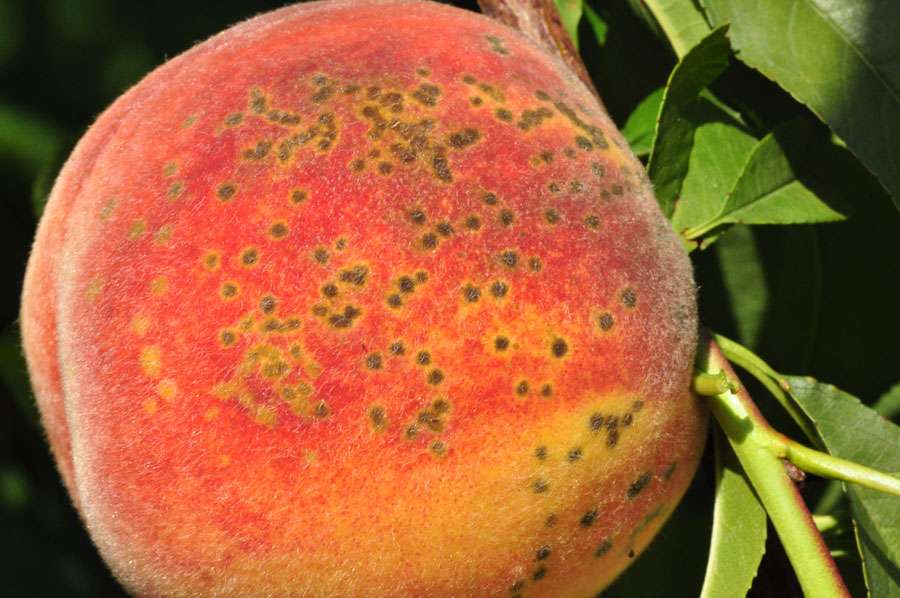My experience with bacterial plant diseases has taught me of the consistent correlation between plant tissue integrity and the opportunity for infection. In my career, I have had the opportunity to conduct extensive tests on four common bacterial soil diseases.
- Bacterial Blight of Walnuts. I focused on the nutritional status of susceptible blocks of walnut trees, versus adjacent blocks that were completely free of disease.
- Peach scab, also known as ink spot. A very interesting disease affecting peach and nectarine trees.
- Bacterial Canker. While I was a young man completing my studies at Modesto Junior College, I had the opportunity to study this disease that commonly infects stone fruits.
- Bacterial Spot. In my first year as a field pathologist, I studied bacterial spot of tomatoes and bacterial spot of peppers.
It was during my time studying bacterial spot that I learned the most important of all lessons in the science of plant pathology. As it was my goal to not merely diagnose the malady, but to treat it as well, I always set out to define the origin and progression (the etiology) of the diseases. I soon learned that the great majority of diseases could be traced to improper plant nutrition. Note that this was not a matter of deficiencies or excesses of certain minerals or nutrients, but an overall imbalance. Remedying imbalanced plant nutrition is the heart of plant pathology.
Below is an overview of what I went on to discover while studying the first three diseases.
Walnut blight is strongly correlated to imbalances in calcium, boron and copper.
The hull tissues from disease-free blocks of walnut trees had 50 times more calcium than hull tissues from diseased trees, while the leaves from disease-free trees had 150 times more calcium than diseased trees.
The foliage from healthy walnut trees had a ratio of calcium to boron of approximately 400 to 1, while sickened trees had a ratio of roughly 110 to 1.
Lastly, foliage from disease-free trees had copper concentrations of 5 ppm, while diseased trees had concentrations that were 11 times higher, 55 ppm.
Peach scab (ink spot) of peaches and nectarines is exacerbated by imbalanced nutrition, rather than heavy metal toxicity or fungicide use.
Some years ago, scientists from UC Davis had concluded that the peach scab affecting a local grower’s trees was symptomatic of heavy metal toxicity, such as occurs when picking crews use aluminum ladders and transfer the aluminum from their stained hands to picked fruit.

However, around this time, the UC Davis Farm Advisors had conducted an examination of many fungicides commonly sprayed on peach trees. They published a report that a popular fungicide. The research director for this manufacturer—a man I highly respected—subsequently visited me and explained his company’s dilemma and their concerns about the potential economic impact of the Farm Advisor’s conclusion. The fungicide in question was and is an excellent product well purposed for the task of preventing fungal diseases, and losing this agricultural tool would have a serious impact on crop growers.
I agreed to design a series of experiments involving the local grower’s trees that would find the cause of ink spot, exonerate the fungicide manufacturer, and help growers prevent this costly disease. I approached this research project from the following foundation of formal knowledge and man years of working in the field:
- The most common issue that impacts the susceptibility of plants to infection is improper nutrition.
- When growers institute improper nutritional programs, their trees are negatively affected. Photosynthetic harvest is reduced, and trees lose their ability to withstand environmental stress such as heat, wind, freezing, and sudden shifts in weather patterns.
- Peach trees and practically all trees and shrubs are covered with dust, debris, spores and bacteria. Peaches are regularly sprayed with fungicides, and while some growers may apply a dormant spray with copper, this practice is becoming obsolete.
When I studied the infected peach trees, I discovered that they had mineral levels in their leaves that were highly imbalanced. Curiously, the affected peaches hosted a substantially greater than normal population of epiphytic bacteria, harmless bacteria which are commonly found on the surfaces of leaves, flowers, roots, and fruit.
I gradually began to understand that improper nutrition was causing peach fruits to form improperly, making them extremely fragile. The weakened epidermis of the fruits would develop fissures and leak their contents. The epiphytic bacteria present on the fruit surface would seize the opportunity to feed on the leaking contents, and would multiply rapidly. The many byproducts resulting from the bacteria’s increased metabolism caused the adjacent fruit cells to die, resulting in the blemishes emblematic of peach scab.
I redesigned the grower’s nutritional program to remedy the mineral imbalances I found, and his trees never saw a recurrence of the disease.
Bacterial canker of stone fruit and nut trees, while technically caused by a bacterial pathogen, can actually be traced to freeze damage.
Bacterial canker is a disease that scientists have shown is caused by the bacterial pathogen Pseudomonas syringae pv. syringae. The bacterium is a common epiphytic bacteria that can be isolated from the surface of many plants, like those I found on the fruit produced by the peach trees mentioned above.
P. syringae has a distinct advantage over other microorganisms living on plant surfaces; it is capable of growing at low temperatures. This is what leads us to the true origin of bacterial canker: freeze damage.
Trees that have low tissue integrity and have been on an inferior nutrition program are very susceptible to freeze damage. This is why plant-parasitic nematodes such as the ring nematode (Criconemella xenoplax), lesion nematode (Pratylenchus species), dagger nematode (Xiphenema americanum), and many others are implicated in the development of bacterial canker.
Any factor that weakens trees will predispose them to bacterial canker:
- Premature defoliation due to mite infestations, shot hole disease, water stress, untimely chemical defoliation, etc.
- Heavy tree cropping which isn’t compensated for with fertility.
- Hot summers, which expose trees to the debilitating ramifications of photorespiration.
- Damage to the root system due to discing, use of lagoon water, Pythium, Phytophthora, etc.
- Pruning by unskilled workers (sometimes referred to as “tree butchers”).
- Stress due to use of chemicals that slow or alter metabolism.
It is the first freeze of the season causes the most damage to the trees, and introduces greatest risk of bacterial canker. Freezes the weak, predisposed tissues—the weakest points on the tree are the fruit buds, the vegetative buds and the terminal bud. However, a severe freeze will take out branches and split the bark and wood.
Following freeze damage, the bases of affected buds exude a microscopic droplet of cell sap. It is invisible to the naked eye and in many instances remains hidden within the cavity formed between the opposing sides of split tissues. When P. syringae comes along, it practically explodes as it quickly metabolizes this secreted cell sap. Cold temperatures don’t slow down the bacterium’s work, as it can metabolize the sap even at 32°F.
Bacteria like P. syringae reproduce incredibly fast, as they reproduce by binary fission, with one cell becoming two, two becoming four, and so on. The equation for bacterial population growth is:
Total Population = P x 2^(T/G), where P = the number of bacterial cells present initially, T = time in hours, and G = the generation time (number of divisions in one hour).
If we start with a single bacterium of P. syringae, and assume that temperatures and nutritional availability are such that there is an average division rate of one per hour, and allow the pathogen to incubate for 24 hours, the population will have expanded to approximately 17 million. Thus, a minor bacterial incursion after a freeze can quickly becoming a rampaging infection.
While this species the bacterium is considered to be capable of motion, they tend to remain localized to the space between the bark and underlying wood. The pathogen produces two glycotoxins, syringomycin and syringotoxin, which are mobilized to distant areas. This explains why bacterial canker lesions are far greater in area than the small region behind the frozen bud.
The most effective way to prevent bacterial canker, as well as the other bacterial soil diseases described above, is to implement a highly balanced plant nutrition program, such as those developed by the SunBurst Agri Biotech Solutions LLC. To learn more about how we can help you diagnose and remedy problems impacting the health of your commercial crops, contact us by calling 866.762.8778 (209.667.4442 for those in the Turlock area), or sending us a message using our site’s contact form.

